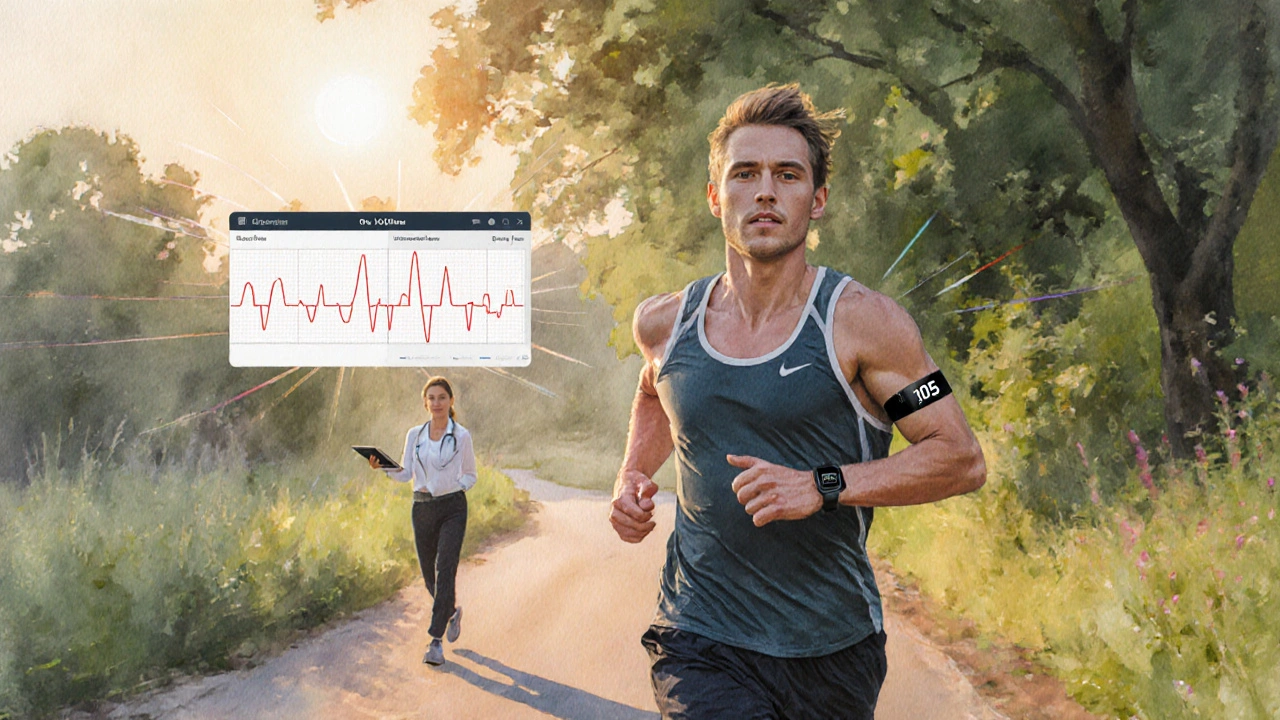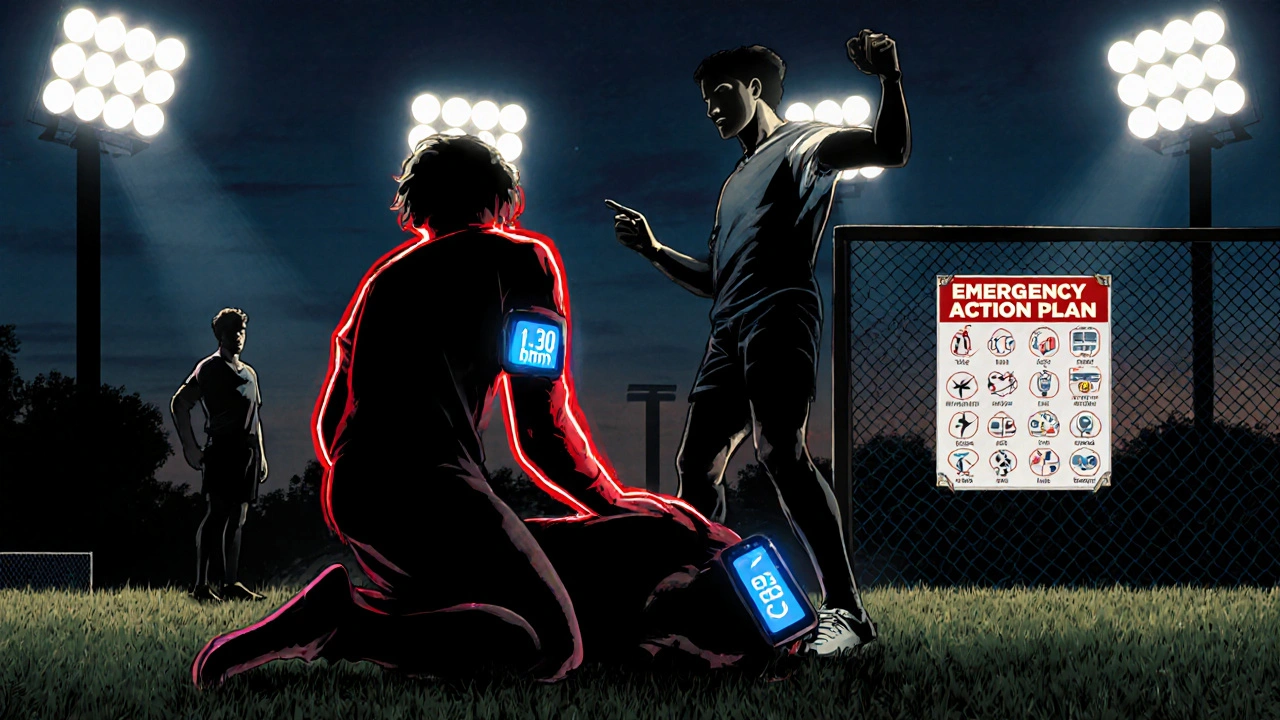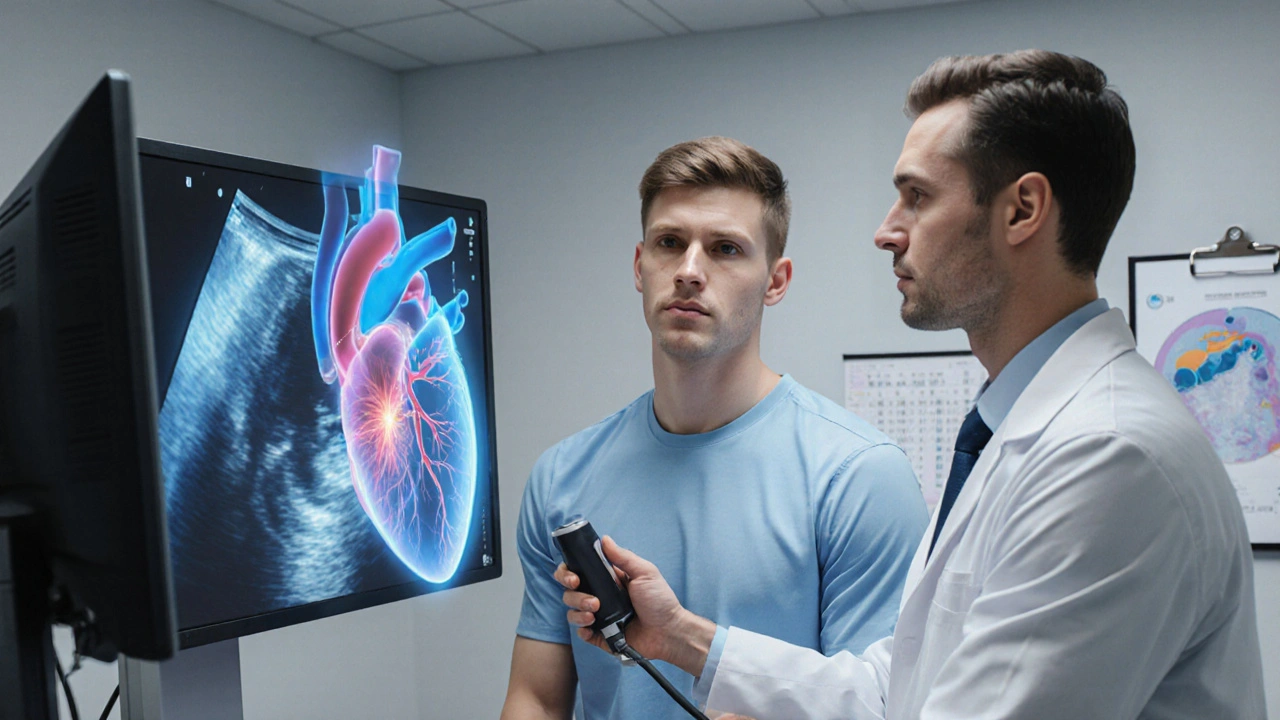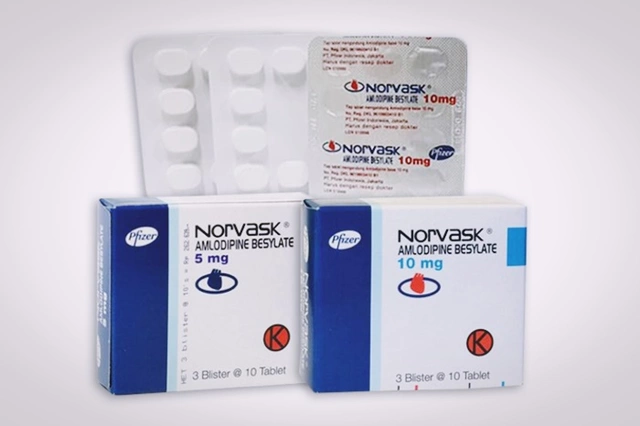HSS Heart Rate Zone Calculator
Personal Information
HSS Severity Assessment
Recommended Heart Rate Zones
Low Intensity (40-55% VO₂max)
Brisk walking, easy cycling, light swimming
Key monitoring: No chest tightness, heart rate < 110 bpm
Moderate Intensity (55-70% VO₂max)
Tempo runs, moderate-pace rowing, circuit weight with 12-15 rep sets
Key monitoring: Stop if shortness of breath or chest discomfort
High Intensity (70-85% VO₂max)
Short sprints, plyometrics, heavy lifts (5-6 rep max)
Stop immediately if chest pain, dizziness, or palpitations occur
Key Takeaways
- Know the signs of hypertrophic subaortic stenosis (HSS) and get regular cardiac screening.
- Work with a sports cardiologist to design a personalized training plan.
- Use medication, devices, or lifestyle tweaks only when recommended by a specialist.
- Monitor heart rate, symptoms, and recovery closely during every workout.
- Have an emergency action plan for sudden cardiac events.
Living with Hypertrophic Subaortic Stenosis doesn’t have to mean quitting the sport you love. The condition-an abnormal thickening of the heart muscle that narrows the outflow tract-can be managed with the right knowledge, medical oversight, and training adjustments. Below is a step‑by‑step guide that helps athletes stay safe while still pushing for peak performance.
Hypertrophic Subaortic Stenosis is a form of hypertrophic cardiomyopathy where the septum bulges into the left ventricular outflow tract, creating a dynamic obstruction that worsens with exertion. The obstruction can trigger chest pain, shortness of breath, or even sudden cardiac arrest during high‑intensity activity. Understanding how the heart responds under load is the first job for any athlete with the diagnosis.
1. Confirm the Diagnosis and Baseline Severity
Before you tweak your training, you need a clear picture of how severe the obstruction is. The gold‑standard evaluations include:
- Echocardiogram is an ultrasound that measures septal thickness and calculates the pressure gradient across the outflow tract.
- Exercise Stress Test reproduces the heart’s response to increasing workloads and pinpoints the workload at which symptoms appear.
- Cardiac MRI offers detailed anatomy, especially useful for assessing scar tissue or abnormal muscle bundles.
If the resting gradient is above 30mmHg or the stress‑induced gradient exceeds 50mmHg, most specialists consider the obstruction clinically significant.
2. Build a Medical Team You Trust
The single most important decision is choosing a Sports Cardiologist experienced in hypertrophic cardiomyopathy and elite‑level athletes. This doctor will interpret test results, prescribe medication, and decide whether an implantable device is needed.
Typical team members include:
- Primary care physician for overall health monitoring.
- Cardiac electrophysiologist if an Implantable Cardioverter Defibrillator (ICD) is recommended.
- Physical therapist or athletic trainer who knows how to modify load without losing conditioning.

3. Medication Management (When It’s Needed)
Not every athlete will need drugs, but beta‑blockers are the most common prescription for HSS. They reduce heart rate and lessen the dynamic obstruction.
- Beta‑blocker dosage is typically titrated to keep resting heart rate between 50‑60bpm. This creates a larger margin before reaching the gradient threshold during exercise.
- Side effects-fatigue, reduced maximal force-can be mitigated with gradual re‑conditioning.
- Never start or stop medication without a physician’s order; abrupt changes can trigger arrhythmias.
4. Tailor Your Training Plan
High‑intensity interval training (HIIT) and heavy resistance work are the biggest triggers for a sudden pressure rise. Instead, follow a periodized plan that emphasizes steady‑state cardio, low‑weight high‑rep strength, and ample recovery.
| Intensity Level | Recommended Activities | Key Monitoring Points | Duration per Session |
|---|---|---|---|
| Low (40‑55% VO₂max) | Brisk walking, easy cycling, light swimming | Heart rate 90‑110 bpm, no chest tightness | 30‑45min |
| Moderate (55‑70% VO₂max) | Tempo runs, moderate‑pace rowing, circuit weight with 12‑15rep sets | Heart rate 110‑130 bpm, monitor for shortness of breath | 45‑60min |
| High (70‑85% VO₂max) - use sparingly | Short sprints, plyometrics, heavy lifts (5‑6rep max) | Heart rate 130‑150 bpm, stop if any pain or dizziness | ≤15min total high‑intensity work, followed by 30min cool‑down |
Every week, include at least one “low‑stress” day where you focus only on mobility and breathing. This reduces sympathetic tone and helps the heart stay relaxed.
5. Real‑Time Monitoring During Workouts
Wearable tech can be a lifesaver-literally. Look for devices that give you:
- Continuous heart‑rate monitoring with alerts at a preset threshold (e.g., 130 bpm).
- ECG patches that detect premature ventricular contractions, a common early warning sign.
- GPS‑based cadence data, so you can relate intensity to heart‑rate trends.
If you notice a sudden spike in heart rate without a corresponding increase in speed or power, stop immediately, sit down, and assess symptoms.
6. Emergency Action Plan (EAP)
Even with meticulous planning, a sudden cardiac event can happen. An EAP should be in place for every practice or competition:
- Designate a teammate or coach trained in CPR.
- Ensure an automated external defibrillator (AED) is within 30seconds of the field.
- Check battery status and pad placement before each session.
- Post clear signage with emergency contact numbers and the athlete’s medical information (e.g., “HSS - medication: metoprolol 25mg”).
- Run a mock drill at least quarterly.

7. Nutrition and Recovery Strategies
Fueling your heart is as important as fueling your muscles.
- Maintain a magnesium‑rich diet (leafy greens, nuts) to support cardiac electrophysiology.
- Stay well‑hydrated; dehydration raises blood viscosity and can increase outflow gradients.
- Consume 1.2‑1.6g protein per kilogram body weight daily to aid muscle repair without overloading the heart with excess calories.
Sleep 7‑9hours per night; growth hormone surges during deep sleep help remodel cardiac tissue in a favorable direction.
8. When to Consider an Implantable Cardioverter Defibrillator (ICD)
Guidelines recommend an ICD for athletes who have any of the following:
- History of syncope (fainting) with exertion.
- Documented ventricular tachycardia on Holter monitoring.
- Family history of sudden cardiac death before age 50.
If an ICD is placed, discuss the device’s impact on contact sports-some leagues require a temporary pause until the wound heals and the device is cleared for impact.
Next Steps for Athletes
- Schedule a comprehensive cardiac work‑up (echo, stress test, MRI).
- Find a sports cardiologist who understands elite training demands.
- Develop a personalized training and monitoring plan using the table above as a baseline.
- Purchase a reliable heart‑rate monitor with customizable alerts.
- Create and rehearse an emergency action plan with your coach and teammates.
Following these steps gives you a clear roadmap to keep competing safely while respecting the limits of your heart.
Frequently Asked Questions
Can I run a marathon with hypertrophic subaortic stenosis?
Yes, but only after a thorough evaluation and a tailored pacing strategy. Most athletes who finish a marathon with HSS keep their heart rate below 130bpm for the majority of the race and incorporate walk‑breaks every 5‑7km.
Do beta‑blockers make me weaker in the gym?
Initially you may feel a dip in maximal strength, especially during explosive lifts. Gradual re‑conditioning, focusing on higher‑rep ranges, and allowing extra recovery time usually restores performance within 6‑8 weeks.
Is it safe to do high‑intensity interval training (HIIT)?
HIIT can be included sparingly, provided you stay below the symptom threshold and keep intervals short (≤30seconds) with full recovery between efforts. Continuous monitoring is a must.
What should I do if I feel chest tightness mid‑workout?
Stop immediately, sit or lie down, and check your heart rate. If the rate remains high or you have pain, call emergency services and have an AED nearby. Most athletes recover quickly after a brief rest, but you must report the episode to your cardiologist.
Can I still play contact sports like rugby?
Contact sports increase the risk of chest trauma to an ICD and raise the chance of arrhythmias. Many cardiologists advise switching to non‑contact alternatives unless the device is fully cleared and protective gear is used.




Richard Phelan
October 12, 2025 AT 13:50Listen up, everybody-if you’re trying to push your HSS limits, you’ve got to treat your heart like a temperamental diva, not a cheap karaoke machine. The low‑intensity zone isn’t just a suggestion; it’s the safety net that keeps you from turning a workout into a headline. Keep that HR under 110 bpm, watch for any chest tightness, and your coach will thank you. Remember, drama belongs on the track, not in your arteries.
Suman Wagle
October 21, 2025 AT 12:25Ah, the age‑old paradox: train hard enough to improve, but not so hard you invite a cardiac coup. If you imagine your heart as a philosophical skeptic, it’ll question every sprint that breaches the caution zone.
Neil Sheppeck
October 30, 2025 AT 11:00Hey all, just a friendly reminder that these zones are tools, not commandments. Mix in some easy cycling or a brisk walk to keep the rhythm gentle, and you’ll stay in the safe zone while still feeling progress.
Stephanie S
November 8, 2025 AT 09:36Indeed, the heart’s performance is *delicately* orchestrated; therefore, meticulous monitoring, precise timing, and unwavering dedication are paramount, so please, double‑check every metric, and never, ever assume the “safe” zone is a free pass.
Bradley Fenton
November 17, 2025 AT 08:11Stick to the low‑intensity recommendations and you’ll be fine.
Wayne Corlis
November 26, 2025 AT 06:46Well, congratulations on discovering the ground‑floor of cardiac safety, but let’s not pretend that a single‑sentence mantra is sufficient for athletes wrestling with hypertrophic subaortic stenosis. First, understand that HSS is not a mere inconvenience; it’s a structural alteration that reshapes how pressure gradients behave during exertion, and that reshaping demands more than a cursory glance at a heart‑rate monitor. Second, the “low‑intensity” label is a moving target, fluctuating with hydration status, medication effects, and even ambient temperature, so relying on a static zone is as naive as assuming the sun will rise at the exact same minute every day. Third, your training log should include subjective markers-how your chest feels, whether you experience any palpitations, and the quality of your breath at specific workloads-because numbers alone can’t capture the nuanced interplay of physiology and perception. Fourth, periodic re‑evaluation by a sports cardiologist is non‑negotiable; they can adjust the gradient thresholds based on evolving echo data, which might shift your “safe” heart‑rate ceiling upward or downward. Fifth, incorporating interval training within the caution zone, while seemingly counterintuitive, can be executed safely only if you employ strict interval lengths (no longer than 30 seconds), ample recovery, and immediate cessation at the first hint of discomfort. Sixth, the psychological component-confidence, anxiety, and adrenaline-can artificially inflate heart rates, so mental preparation and stress‑reduction techniques are essential allies. Seventh, nutrition plays a silent but significant role; a low‑carb meal before a high‑intensity session could spike heart rate independent of workload, misleading your assessment. Eighth, consider wearable tech that tracks HR variability as an extra layer of insight; sudden drops in variability often precede arrhythmic events. Ninth, never underestimate the value of an AED on‑site; it’s not a matter of “if” but “when” that you’ll need it, and preparedness can be the difference between a quick recovery and a tragic outcome. Tenth, educate your training partners about the warning signs so they can intervene promptly-everyone benefits from a shared safety net. Eleventh, keep an emergency action plan in your gym bag: a phone number for your cardiologist, a list of medications, and a clear protocol for calling emergency services. Twelfth, embrace the “use sparingly” philosophy for high‑intensity bursts; think of them as fireworks-exciting but best limited to special occasions. Thirteenth, after every session, log your subjective recovery score; a persistently low score may indicate cumulative stress that the heart‑rate numbers don’t reveal. Fourteenth, remember that age and disease progression can shift your baseline, so what worked last season may no longer be adequate. Finally, accept that the journey with HSS is an evolving partnership between you, your medical team, and your body-respect the limits, but also celebrate the victories when you stay within them.
Kartikeya Prasad
December 5, 2025 AT 05:22Alright, folks, the calculator is neat, but don’t forget to actually listen to your body-if you’re feeling shaky, grab a water bottle and chill out 😅.